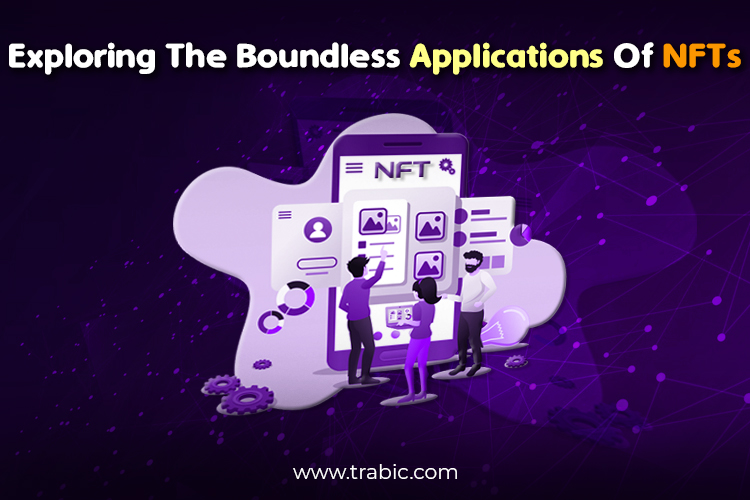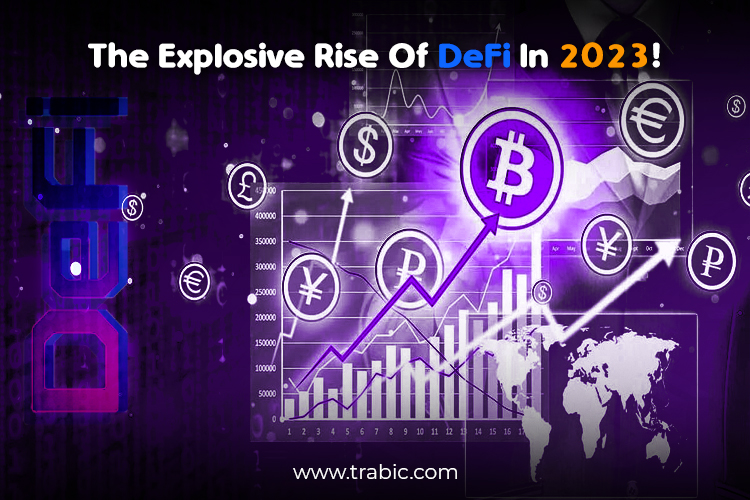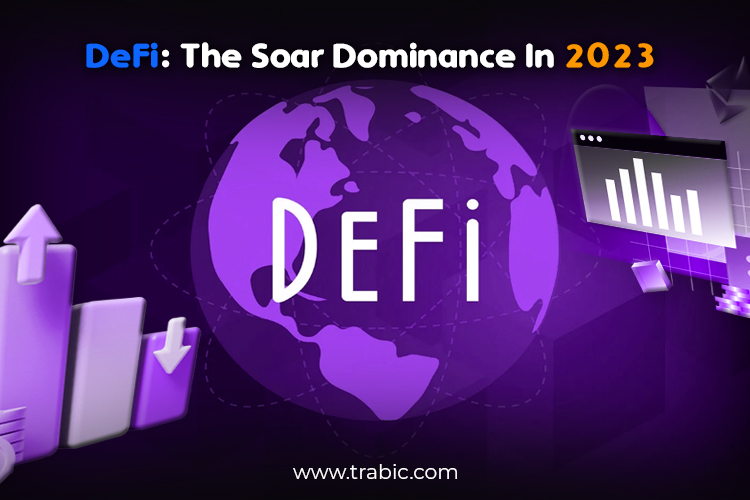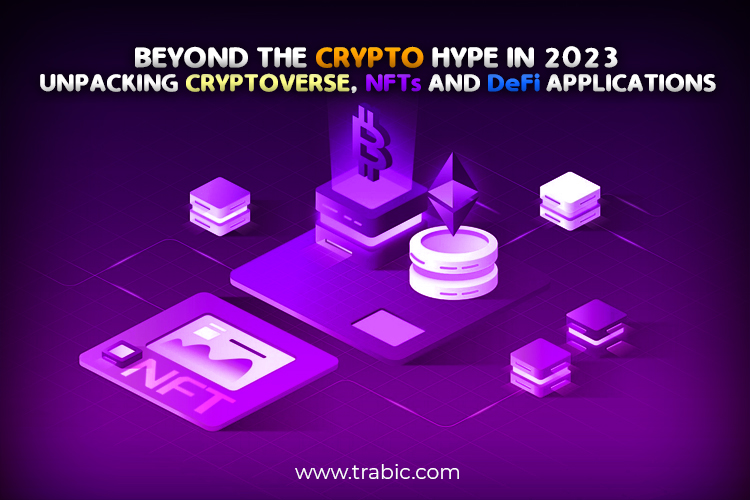NFTs, the veritable jewels of the cryptoverse, have transcended their humble origins as mere collectibles to become transformative vehicles of art, culture, and intellectual property. In the ethereal world of NFT artistry, creators now bask in newfound sovereignty over their digital masterpieces.
Cryptocurrencies have been rapidly evolving since their inception, and 2023 has proven to be a pivotal year for the cryptoverse. Two of the most revolutionary developments in this space are Non-Fungible Tokens (NFTs) and Decentralized Finance (DeFi). This blog will delve into the exciting applications of NFTs and DeFi in 2023 and how they are transforming various industries and reshaping the financial landscape.
In the dazzling realm of the cryptoverse, where innovation knows no bounds, 2023 has unveiled a breathtaking metamorphosis in the landscape of digital assets. From the groundbreaking emergence of Non-Fungible Tokens (NFTs) to the meteoric rise of Decentralized Finance (DeFi), the convergence of cryptocurrencies has given birth to an exhilarating tapestry of possibilities. This transcendent fusion of cutting-edge blockchain technology and boundless creativity has paved the way for many exciting applications that transcend traditional notions of finance and ownership.
At the same time, enthusiasts revel in the ability to partake in the ownership of these unique and inimitable tokens. But the journey doesn’t end there; the realm of NFTs has branched out to encompass a breathtaking array of applications, from virtual real estate to tokenized experiences, where individuals can claim their stake in the virtual landscapes of metaverses.
Enter DeFi, the indomitable force revolutionizing the very fabric of finance. Empowered by the principles of decentralization, DeFi platforms are rendering archaic intermediaries obsolete, liberating users from the shackles of traditional banking systems. In the grand theater of decentralized exchanges, liquidity pools, and lending protocols, participants now shape their financial destinies, forging a new path of inclusivity and financial sovereignty. The crypto verse’s financial playground has expanded exponentially, welcoming seasoned traders and novices and beckoning them into borderless and permissionless economic transactions.
As the dynamic dance between NFTs and DeFi commences, their union brings forth an exhilarating symphony of innovation. Witness the dawn of fractionalized NFTs, where previously untouchable assets are shattered into divisible fragments, opening the door for fractional ownership and investment opportunities. Behold the emergence of NFT-backed collateralization within DeFi protocols, where digital art and rare collectibles unlock new liquidity and financial leverage avenues.
Beyond the borders of art and finance, the cryptoverse spills into the domain of identity verification, where immutable digital credentials enable secure and efficient cross-border interactions. It infiltrates the realm of supply chain management, ensuring transparency and traceability of goods through cryptographic authentication. Even the world of gaming metamorphoses as play-to-earn models empower players to monetize their virtual prowess and redefine the concept of leisure.
In this extraordinary juncture, the cryptoverse transcends mere speculation and enters the realm of tangible utility, empowering individuals to navigate uncharted financial territories and harness the potential of their digital assets. As we venture deeper into the labyrinthine marvels of NFTs and DeFi in 2023, the cryptoverse invites pioneers and dreamers to revel in the transformative power of this decentralized revolution. The cryptoverse is no longer a glimpse of the future; it is the vibrant reality pulsating with life, beckoning us to participate in its unfolding saga.
Understanding NFTs and Their Applications:

NFTs have taken the world by storm, revolutionizing how we perceive ownership and value. In simple terms, NFTs are unique digital assets representing ownership of a particular item, artwork, music, virtual real estate, or even physical assets like real estate and luxury goods. Their uniqueness and scarcity are guaranteed by blockchain technology, making them tamper-proof and transparent.
In 2023, NFTs have found exciting applications in various domains:
- Art and Entertainment: NFTs have already disrupted the art world, empowering artists to tokenize their creations and directly sell them to collectors without intermediaries. Moreover, musicians and filmmakers are leveraging NFTs to create unique music albums, virtual concerts, and exclusive screenings, providing fans with a new engagement level.
- Gaming and Virtual Real Estate: Blockchain-based gaming has gained immense popularity. NFTs enable players to own in-game assets, characters, and virtual real estate, fostering a vibrant player-driven economy. Gaming studios are integrating NFTs into their ecosystems, resulting in a more immersive and rewarding gaming experience.
- Intellectual Property and Licensing: NFTs offer an innovative solution for content creators, allowing them to protect their intellectual property, establish provenance, and receive royalties whenever their work is resold in the secondary market.
The Rise of DeFi in 2023:

Decentralized Finance (DeFi) has emerged as a game-changer, bringing traditional financial services to the blockchain without intermediaries. DeFi projects are built on smart contracts, ensuring transparency, security, and efficiency.
The critical applications of DeFi in 2023 are as follows:
- Decentralized Lending and Borrowing: DeFi platforms have facilitated peer-to-peer lending and borrowing, enabling users to access loans without traditional banks. This decentralized approach eliminates geographic barriers and provides better interest rates to both lenders and borrowers.
- Automated Market Makers (AMMs): AMMs are decentralized exchanges that use algorithms to set token prices and facilitate trading. They have revolutionized liquidity provision and trading in the cryptoverse, allowing users to swap tokens effortlessly.
- Yield Farming and Staking: DeFi has introduced innovative ways for users to earn passive income. Yield farming and staking involve locking up cryptocurrencies in smart contracts to receive rewards or fees, promoting network participation and governance.
- Synthetic Assets: DeFi protocols increasingly offer synthetic assets, which are blockchain-based tokens that mimic the value of real-world assets like stocks, commodities, or fiat currencies. This opens up investment opportunities and hedging strategies within the crypto ecosystem.
Synergies between NFTs and DeFi
One of the most exciting developments in the cryptoverse is the convergence of NFTs and DeFi. NFTs are used as collateral in DeFi lending platforms, enabling users to borrow against their unique digital assets. This provides liquidity to NFT holders without needing to sell their prized possessions.
Furthermore, DeFi protocols incorporate NFT-based gamification to incentivize participation and reward users for their contributions. This integration is reshaping the financial landscape, fostering innovation, and expanding the possibilities of decentralized finance.
Let’s explore more points on the exciting applications of NFTs and DeFi in the cryptoverse in 2023:
NFTs:
- Virtual Identities and Metaverse: NFTs play a crucial role in shaping virtual identities within the metaverse. Users can own unique avatars, digital wearables, and virtual real estate, representing their presence in various metaverse platforms. This ownership enhances social interactions and personalization in virtual worlds.
- Collectibles and Gaming Crossovers: NFTs have bridged the gaming and collectibles industries. In-game items, character skins, and unique collectibles can be tokenized as NFTs, allowing players to trade, sell, and own these digital assets within and outside the gaming ecosystem.
- Tokenized Real-World Assets: In 2023, the tokenization of real-world assets will see significant growth. NFTs will represent ownership of physical assets like real estate, luxury items, and rare collectibles, facilitating fractional ownership and making these traditionally illiquid assets more achieved to a broader range of traders.
DeFi (Decentralized Finance):
- Governance and Decentralized Autonomous Organizations (DAOs): DeFi projects often implement governance mechanisms that allow token holders to participate in decision-making processes. These decentralized autonomous organizations (DAOs) enable community-driven initiatives, making the ecosystem more democratic and resilient to central control.
- Insurance: DeFi insurance protocols have emerged, providing coverage against intelligent contract vulnerabilities, exchange hacks, and other risks in the crypto space. Users can protect their assets and investments with insurance products that are based on blockchain technology and governed by the community.
- Cross-Chain Interoperability: As the crypto space becomes more fragmented with various blockchains and protocols, cross-chain DeFi solutions are gaining traction. Projects are working on interoperability solutions to enable seamless asset transfers and interactions across different blockchain networks, fostering a more connected and efficient cryptoverse.
- Environmental Initiatives: DeFi projects are increasingly focusing on sustainability and mitigating the environmental impact of blockchain networks. Efforts to transition to more energy-efficient consensus mechanisms like proof-of-stake (PoS) are gaining momentum, promoting greener alternatives to the energy-intensive proof-of-work (PoW) protocols.
- Decentralized Identity (DID): DeFi is spearheading the development of decentralized identity solutions. Users can control their data, allowing them to share specific information with services and Crypto platforms without compromising privacy.

NFTs (Non-Fungible Tokens) and DeFi (Decentralized Finance) are significant innovations in the world of cryptocurrencies, but they serve different purposes and have different characteristics. Let’s explore the key differences between NFTs and DeFi:
- Definition and Purpose:
- NFTs: Non-Fungible Tokens are unique digital assets representing ownership of a specific item or content. They are indivisible and cannot be exchanged on a one-to-one basis with other tokens, as each NFT has its distinct value and properties. NFTs are primarily used to tokenize digital and physical assets, creating provable ownership and scarcity in the digital realm.
- DeFi: Decentralized Finance refers to a set of financial services and applications built on blockchain technology without the need for intermediaries like banks or financial institutions. DeFi aims to provide transparent, accessible, decentralized alternatives to traditional financial systems. It includes lending, borrowing, decentralized exchanges, yield farming, and other financial services, all executed through smart contracts on decentralized platforms.
- Fungibility and Interchangeability:
- NFTs: Non-Fungible Tokens are unique and non-interchangeable. Each NFT has its distinct value and cannot be replaced one-to-one with another token. For example, an NFT representing a specific digital artwork cannot be exchanged directly for another NFT representing a different artwork.
- DeFi: Decentralized Finance typically involves using fungible tokens, such as Ethereum (ETH), ERC-20 tokens, or other interchangeable cryptocurrencies with the same value. Fungible tokens can be exchanged with others on a one-to-one basis, making them suitable for financial transactions and liquidity provision.
- Use Cases:
- NFTs: Non-Fungible Tokens find application in various industries, including art, gaming, collectibles, music, virtual real estate, and intellectual property. They enable creators to tokenize their work, establishing provable ownership and offering unique experiences and rewards to their audiences.
- DeFi: Decentralized Finance use cases include decentralized lending and borrowing, yield farming, decentralized exchanges (DEXs), stablecoins, and insurance. DeFi platforms facilitate financial interactions without intermediaries, giving users greater control over their assets and access to various financial services.
- Ownership and Value:
- NFTs: Owning an NFT means owning a unique digital asset tied to a specific item or content. The value of an NFT is often subjectively determined by its rarity, historical significance, demand, and the creator’s reputation. NFT ownership grants specific rights, such as reselling the NFT on secondary markets and potentially earning royalties from subsequent sales.
- DeFi: In DeFi, owning fungible tokens provides users access to various financial services and governance rights within the ecosystem. The value of these tokens is typically based on their utility and demand within the DeFi protocols and the broader market sentiment.
In summary, NFTs and DeFi serve different purposes in the crypto space. NFTs focus on unique ownership and tokenization of specific assets and content, while DeFi provides decentralized financial services and applications using fungible tokens. Both NFTs and DeFi have contributed significantly to the growth and innovation in the cryptocurrency and blockchain industry, offering exciting possibilities for creators, users, and investors alike.
The scope of NFTs (Non-Fungible Tokens) is vast and continually expanding as these unique digital assets gain popularity and adoption across various industries. Here are some key areas where NFTs have a significant scope:
- Art and Collectibles: NFTs have disrupted the art world, allowing artists to tokenize their digital artworks and sell them directly to collectors on blockchain platforms. NFTs provide provenance, scarcity, and authenticity to digital art, creating new opportunities for artists and revolutionizing how art is valued and traded. Additionally, NFTs have opened up the world of digital collectibles, where unique virtual items, trading cards, and in-game assets can be tokenized and owned by users.
- Gaming and Virtual Real Estate: NFTs have found extensive applications in the gaming industry. In blockchain-based games, players can own, trade, and use NFTs representing in-game items, characters, and virtual real estate. NFTs enable actual ownership of virtual assets, allowing players to monetize their gaming experiences and create player-driven economies.
- Music and Entertainment: Musicians and content creators leverage NFTs to tokenize their music albums, exclusive tracks, concert tickets, and other digital content. NFTs offer new revenue streams and ways to engage with fans, including unique experiences and rewards for token holders.
- Intellectual Property and Licensing: NFTs have the potential to revolutionize intellectual property rights and licensing. Content creators can tokenize their work, ensuring transparency and control over the usage and distribution of their creations. NFTs can also facilitate licensing agreements, enabling automated royalty payments to the original creators whenever their content is used or resold.
- Virtual Identities and Metaverse: NFTs are shaping virtual identities within the metaverse. Users can own unique avatars, digital wearables, and virtual real estate, representing their presence in various virtual worlds and social platforms. NFTs enhance personalization and social interactions in virtual environments.
- Real-World Asset Tokenization: NFTs are being explored to represent owners of real-world assets like real estate, luxury items, and collectibles. By tokenizing these assets, NFTs can enhance liquidity, fractional ownership, and accessibility to a broader range of investors.
- Charity and Fundraising: NFTs have been used for charitable causes and fundraising initiatives. Artists and creators can donate or auction their NFTs to raise funds for various charitable organizations and social causes, facilitating transparent and traceable donations.
- Education and Certification: NFTs can verify and authenticate educational certificates, diplomas, and achievements. By tokenizing academic credentials, individuals can have immutable proof of their educational qualifications, making the verification process more efficient and secure.
- Advertising and Marketing: NFTs are used in innovative advertising and marketing campaigns. Brands can create unique branded NFTs or offer NFT-based rewards to customers, enhancing brand engagement and loyalty.
The scope of NFTs continues to evolve as more industries and use cases explore the potential of this technology. As blockchain technology becomes mainstream, we can expect even more diverse applications of NFTs, driving further adoption and innovation in the digital asset space.
The scope of DeFi (Decentralized Finance) is vast and transformative, as it aims to revolutionize traditional financial systems by leveraging blockchain technology and contracts. Here are some key areas where DeFi has significant scope:
- Decentralized Lending and Borrowing: DeFi platforms offer decentralized lending and borrowing services, allowing users to lend their cryptocurrencies and earn interest or borrow assets without traditional financial intermediaries. This opens up access to credit and lending opportunities for individuals and businesses globally.
- Automated Market Makers (AMMs): DeFi has led to decentralized exchanges (DEXs) with automated market makers. AMMs use algorithms to set token prices and facilitate trading without order books. This innovation has significantly improved liquidity provision and accessibility to a wide range of tokens.
- Yield Farming and Staking: DeFi has introduced yield farming and staking, where users can lock up their cryptocurrencies in intelligent contracts to earn rewards or fees. These mechanisms incentivize network participation and contribute to the security and governance of DeFi protocols.
- Synthetic Assets: DeFi platforms offer synthetic assets that represent the value of real-world assets like stocks, commodities, and fiat currencies. This allows users to gain exposure to traditional financial markets without leaving the crypto ecosystem.
- Insurance: DeFi insurance protocols provide coverage against intelligent contract vulnerabilities, exchange hacks, and other risks in the crypto space. Users can protect their assets and investments through decentralized insurance products.
- Decentralized Identity (DID): DeFi is driving the development of decentralized identity solutions. Users can control their data and selectively share information with services and platforms without compromising privacy.
- Stablecoins: DeFi has been a major catalyst for developing stablecoins, cryptocurrencies designed to maintain a stable value by being pegged to real-world assets like fiat currencies. Stablecoins provide a reliable store of value and facilitate seamless trading within DeFi ecosystems.
- Governance and DAOs: Many DeFi projects implement governance mechanisms using DAOs (Decentralized Autonomous Organizations). Token holders participate in decision-making processes, voting on proposals and upgrades, making the ecosystem more democratic and community-driven.
- Cross-Chain Interoperability: DeFi is exploring solutions for cross-chain interoperability, enabling seamless asset transfers and interactions across different blockchain networks. This fosters a more connected and efficient DeFi landscape.
- Financial Inclusion: DeFi has the potential to promote financial involvement by giving access to financial services to people who are unbanked or underbanked. Any individual with an internet connection can participate in DeFi platforms without relying on traditional banking infrastructure.
The scope of DeFi is continually expanding, with ongoing development and experimentation in various areas. As the technology grows and becomes widely adopted, DeFi has the potential to reshape the global financial landscape, providing decentralized, transparent, and inclusive financial services to a broader audience. However, it’s essential to consider that DeFi is still an evolving space, and users should exercise caution and conduct due diligence when participating in DeFi protocols.
Conclusion:
In conclusion, 2023 has proven to be a transformative period for the cryptoverse, with two groundbreaking developments taking center stage: NFTs (Non-Fungible Tokens) and DeFi (Decentralized Finance). These innovations have significantly impacted various industries, reshaping how we perceive ownership, value, and financial services in the digital age.
NFTs have disrupted traditional notions of art, collectibles, and ownership. Artists, musicians, gamers, and content creators have embraced NFTs to tokenize their work, establish provenance, and engage with their audiences in novel ways. NFTs have empowered creators to monetize their digital assets while collectors and users benefit from authentic ownership experiences.
Simultaneously, DeFi has revolutionized finance by providing accessible, transparent, and decentralized financial services on blockchain platforms. DeFi projects have enabled lending, borrowing, yield farming, and automated market-making without intermediaries, offering users greater control over their assets and participation in financial ecosystems.
The synergy between NFTs and DeFi has been remarkable, leading to the tokenization of NFTs and their use as collateral in DeFi lending protocols. This integration has created new possibilities, such as accessing liquidity without selling NFTs and participating in gamified DeFi ecosystems.
The scope of NFTs encompasses various industries, including art, gaming, music, virtual real estate, and intellectual property. NFTs have transformed how creators interact with their audiences, and users experience digital content and virtual environments.
Likewise, the scope of DeFi has been transformative in providing financial services beyond borders and traditional financial institutions. DeFi has introduced novel financial products, synthetic assets, decentralized identity, and cross-chain interoperability, all contributing to the growth and democratization of the global financial ecosystem.
As the cryptoverse evolves, the applications and synergies between NFTs and DeFi will likely expand further. We can expect increased adoption, innovation, and cross-industry collaborations, paving the way for a more decentralized, inclusive, and interconnected future.
However, it’s essential to acknowledge that the cryptoverse is still a rapidly evolving space, and challenges such as scalability, security, and regulatory concerns must be addressed. Users and participants should exercise caution, conduct due diligence, and stay informed about the risks of engaging in NFTs and DeFi protocols.
Overall, the journey from NFTs to DeFi in 2023 has been exhilarating, offering a glimpse into the immense potential of cryptocurrencies in transforming industries and reshaping the financial landscape. As these technologies mature, the cryptoverse will continue to captivate our imagination and drive innovation, shaping a more decentralized, connected, and vibrant digital future.
